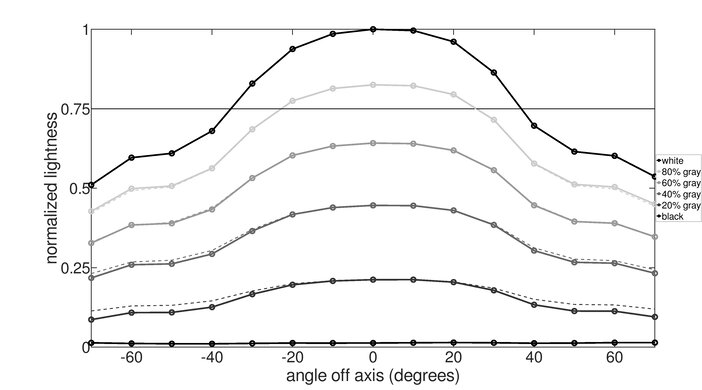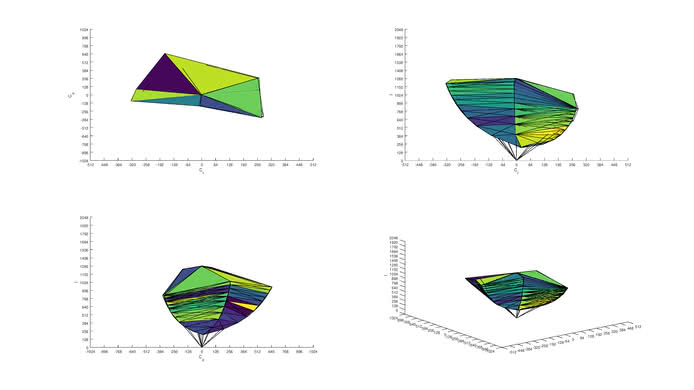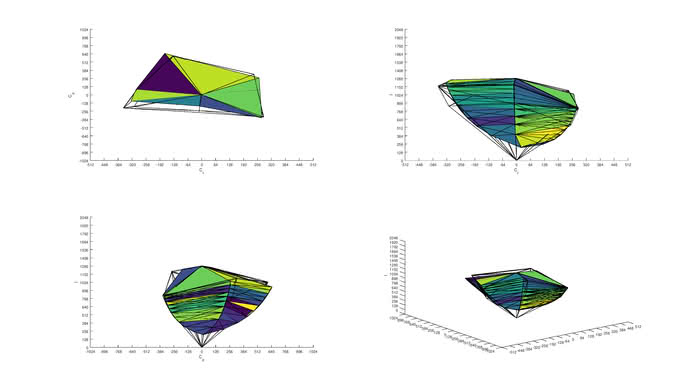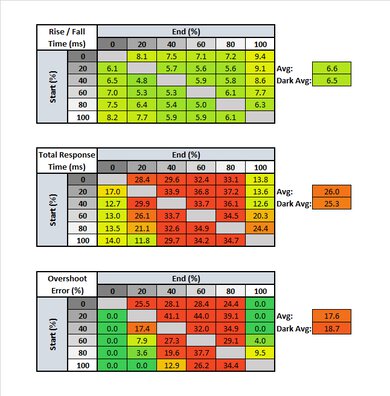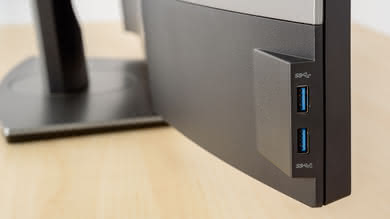Our Verdict
The Dell U3818DW is a good monitor for most uses. It has a good stand that can easily be adjusted to an optimal viewing position. It gets decently bright and has very good reflection handling, great for a bright room. The high-resolution, large screen is great for multitasking or for an immersive gaming experience. It has low input lag and decent motion handling.
- Image remains accurate when viewed at an angle
- Excellent out of the box accuracy
- Lots of screen real-estate great for multitasking
- Noticeable motion smearing caused by overshoot
- Blacks appear gray in a dark room
Very good monitor for office use. The monitor can display two inputs at the same time, great if you telecommute and have a work and personal computer on the same desk. The stand is easily adjustable to an ideal viewing position. It has very good viewing angles, which is really important with a screen this size.
Very good monitor for gaming. It has decent motion handling, but the overshoot may cause some noticeable smearing in motion. It has excellent low input lag regardless of input resolution. The large, high-resolution curved screen provides a more immersive gaming experience. Some gamers may be disappointed by the 60Hz refresh rate and lack of VRR support.
Good monitor for multimedia. It has decent motion handling and a great response time, so there is little motion blur in fast moving objects. It has very good viewing angles, great for sharing the latest YouTube trends with some friends. Unfortunately, it doesn't look as good in a dark room due to the mediocre contrast ratio, as blacks look gray in a dark room.
This is a good monitor for media creation. It has a large, high-resolution screen that allows you to see more of your project at once. It has very good viewing angles, great for sharing your project with a nearby coworker. Unfortunately, the Adobe RGB color gamut coverage is less than ideal for professionals working in photo or video editing.
The Dell Ultrasharp U3818DW does not support HDR. For a good HDR monitor, check out the Samsung CHG70.
Changelog
- Updated Jun 11, 2020: Converted to Test Bench 1.1.
- Updated Nov 06, 2018: There was an error with the curve radius scoring which has been fixed. This has not changed the usage scores for this monitor.
- Updated Oct 24, 2018: Review published.
- Updated Oct 22, 2018: Our testers have started testing this product.
Check Price
Differences Between Sizes And Variants
We tested the 38" Dell U3818DW. Dell offers similar models in other sizes, but they perform differently from the U3818DW.
If someone comes across a different type of panel or if their Dell U3818DW doesn't correspond to our review, let us know and we will update the review. Note that some tests such as the gray uniformity may vary between individual units.
| Model | Size | Resolution | Refresh Rate | Notes |
| U3818DW | 38" | 3840x1600 | 60Hz | |
| U3417W | 34" | 3440x1440 | 60Hz | |
| AW3418DW | 34" | 3440x1440 | 100Hz | G-SYNC |
The U3818DW we reviewed was manufactured in May 2018.
Popular Monitor Comparisons

The Dell U3818DW is a great office monitor with some impressive features, but these features come at a premium price. See our recommendations for the best gaming monitors for PC, the best curved gaming monitors, and the best 4k gaming monitors.
The Dell U3818DW and the Dell U4919DW are very similar. The larger screen on the U4919DW is easier for multitasking and offers a more immersive gaming experience. The U3818DW has a better stand, with a better height adjustment, and it can swivel.
The LG 38WN95C-W is much better than the Dell U3818DW. The LG gets much brighter, supports HDR, displays a wider color gamut, and it has more gaming features like VRR support and a 144Hz refresh rate. However, the Dell has better ergonomics, has better color accuracy, and there two more USB ports.
Although the LG 38GL950G-B and the Dell U3818DW share the same screen size, aspect ratio, and resolution, the LG performs significantly better than the Dell for most uses. The LG has an outstanding response time, high refresh rate, and it supports VRR. Also, the LG gets brighter, it has lower input lag, and it supports HDR. However, the Dell has better ergonomics, wider viewing angles, and a much better color accuracy.
The Dell Alienware AW3821DW is better overall than the Dell U3818DW, mainly because it has a lot more gaming features. The AW3821DW has a native 144Hz refresh rate and it has G-SYNC support, while the AW3818DW is limited to 60Hz and doesn't have VRR support. The AW3821DW's much quicker response time results in smooth motion, and it supports HDR. However, the AW3818DW is designed as a productivity monitor and has a few more office-oriented features such as Picture-in-Picture/Picture-by-Picture modes as well as a USB-C input that supports DisplayPort Alt Mode.

We buy and test more than 30 monitors each year, with units that we buy completely on our own, without any cherry-picked units or samples. We put a lot into each unbiased, straight-to-the-point review, and there's a whole process from purchasing to publishing, involving multiple teams and people. We do more than just use the monitor for a week; we use specialized and custom tools to measure various aspects with objective data-based results. We also consider multiple factors before making any recommendations, including the monitor's cost, its performance against the competition, and whether or not it's easy to find.
Test Results

The stand is identical to the older U3417W. It has a unique trapezoid shape, and like most Dell stands, it is very slim, allowing you to place small objects directly in front of the monitor.
Mediocre ergonomics. The height of the monitor can be adjusted, and it can tilt and swivel, so you can easily turn your monitor for an impromptu meeting at your desk. The display can't be rotated, but with the large, curved design, you wouldn't really want to anyway.
The borders are thin and look good. They are the same thickness as the Dell U3417W, and slightly thinner than the ASUS PG348Q.
Because of the curved screen, the monitor looks thick when viewed edge-on. It is thinner than the U3417W due to the less aggressive curve. When VESA mounted, it is very thin, especially for a curved monitor this size (see our recommendations for the best curved monitors).
The Dell U3818DW has a mediocre contrast ratio, but slightly better than the Dell U3417W. Unfortunately, there is no local dimming feature that could improve dark room performance.
Like the Dell U3417W, the contrast ratio was measured with Uniformity Compensation disabled. With this set to 'Calibrated', the contrast ratio is cut to 604:1.
There is no local dimming feature on this monitor. The video is for reference only.
The Dell Ultrasharp U3818DW is decently bright, and the brightness does not change with different content, which is great. It is a bit brighter than the Dell Alienware AW3418DW.
HDR is not supported on this monitor. If you want an ultrawide monitor with HDR support, check out the LG 38WN95C-W.
The monitor has good horizontal viewing angles. Given the size of the monitor, this is extremely important to ensure that the entire image remains uniform when sitting up close.
Excellent vertical viewing angles, typical of IPS panels. The brightness and colors shift at slightly narrower angles than the U3417W, but not enough to be noticeable or cause any issues. The black levels stay relatively flat at any angle, which is great.
The Dell Ultrasharp U3818DW has great gray uniformity. There are some dark vertical bands visible, but these are not noticeable under normal viewing conditions. There also isn't much DSE, which is great for browsing the web or watching streaming sports. Uniformity in near-dark scenes is much better, and there is almost no DSE.
Like the Dell U3417W, the gray uniformity was measured with Uniformity Compensation disabled. Setting this to 'Calibrated' did not significantly improve the uniformity, but cut the contrast ratio in half, so we don't recommend it.
The Ultrasharp U3818DW has outstanding accuracy out of the box. White balance and color accuracy dE are very low, and even enthusiasts likely won't be able to notice any inaccuracies. Gamma follows the target curve nearly perfectly, and the color temperature is only slightly cool.
The color accuracy and white balance are nearly perfect after calibration, but the Gamma is slightly worse. Color temperature is slightly warm after calibration.
You can download our ICC profile calibration here. This is provided for reference only and should not be used, as the calibration values vary per individual unit even for the same model due to manufacturing tolerances.
s.RGB Picture Mode: Custom Color (calibrated)
Adobe RGB Picture Mode: Custom Color
Excellent SDR color gamut. Standard s.RGB color space coverage is nearly perfect, but coverage of the wider Adobe RGB coverage is limited. Overall, the Dell Ultrasharp U3818DW is great for daily use, but isn't ideal for professional photo or video editing.
s.RGB Picture Mode: Custom Color
Adobe RGB Picture Mode: Custom Color
Excellent color volume. The U3818DW can produce bright colors across the s.RGB color space without issue. Unfortunately, it can't produce deep, dark colors in either color space due to the limited contrast ratio.
HDR is not supported on this monitor.
HDR is not supported on this monitor.
Great reflection handling, similar to the Dell Alienware AW3418DW. There should be no issues using this monitor in a bright room.
Response Time Normal
Response Time Fast
The monitor has a very good response time, slightly worse than the Dell U3417W. There are only two overdrive settings, and unfortunately in both modes there is significant overshoot in some transitions that causes smearing in motion that may bother some people.
If you want a monitor with faster response time, check out the LG 38GL950G-B.
The Dell U3818DW has a standard 60Hz refresh rate that is fine for most users, may disappoint more demanding gamers. There's also no FreeSync or G-SYNC VRR support. If you prefer a gaming monitor with a higher refresh rate and VRR support, look into the Dell Alienware AW3821DW.
Non-native resolution tested: 2560 x 1080 @ 8-bit.
Excellent low input lag. The Dell Ultrasharp U3818DW only supports non-native resolutions in 8-bit, but this shouldn't cause any issues if you want to use 10-bit, as most graphics cards will upscale without you knowing.
Non-native resolutions are only displayed when sending 8-bit, otherwise, they are displayed at the native resolution. Non-native input lag is ever so slightly higher, but still excellent.
The monitor has a great 38" screen and impressive 3840x1600 resolution. This rather uncommon resolution is sometimes known as WQHD+, and is great for multitasking, or for watching widescreen 4k content. If you want a similar-sized monitor with an even higher, 5k resolution, check out the Dell UltraSharp U4021QW.
There is an audio line-out port, but it is meant to only be used for speakers, as the volume can't be controlled.
There are 4 USB 3.0 ports, and a USB-C port that can be used with DisplayPort Alt mode, allowing you to connect a laptop to the monitor and charge it with a single cable. USB Power Delivery mode on the U3818DW can deliver up to 95W of power.
Unlike the U3417W, the U3818DW does not have a DisplayPort out, so it can't be daisy-chained with another monitor.
The Dell U3818DW has some impressive additional features. It is designed to connect to two computers at the same time. There are separate USB upstream ports that allow the monitor to function as a KVM switch by connecting your keyboard and mouse to the USB ports on the monitor. With the Picture-in-Picture or Picture-by-Picture mode, you can display two computers on the screen at the same time, and easily work with both. It has built in speakers, but no HDR support.
The controls on this monitor are very similar to other Dell monitors, including the U3417W. The buttons are small, but they are a bit stiff and aren't comfortable if you plan on making frequent adjustments. There are programmable quick buttons that can make this easier though.














